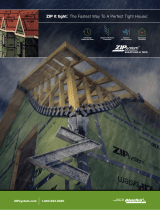
*Note: Cleaning, degreasing, and promoting
products are commonly regulated for volatile
organic compound (VOC) content. Please
consult your local Air Quality Regulations to
be sure the cleaner is compliant. When using
solvents, be sure to follow the manufacturer’s
precautions and directions for use when
handling such materials.
October 2013
Application Information
3M
™
Solar Acrylic Foam Tape
Application Techniques
Cleaning
Most substrates are best prepared by cleaning
with a 50:50 mixture of isopropyl alcohol (IPA*)
and water prior to applying 3M
™
Solar Acrylic
Foam Tapes.
Exceptions to the general procedure that may
require additional surface preparation include:
• Heavy Oils: A degreaser or solvent-based
cleaner may be required to remove heavy oil or
grease from a surface and should be followed
by cleaning with IPA/water.
• Abrasion: Abrading a surface, followed by
cleaning with IPA/water, can remove heavy dirt
or oxidation and can increase surface area to
improve adhesion.
• Adhesion Promoters: Applying an Adhesion
Promoter on a surface can significantly improve
initial and ultimate adhesion to many materials
such as plastics and paints.
•
Porous surfaces: Most porous and fibered
materials such as wood, particleboard,
concrete, etc. need to be sealed to provide
a unified surface.
• Unique Materials: Special surface preparation
may be needed for glass and glass-like
materials, copper and copper containing metals,
and plastics or rubber that contain components
that migrate (e.g. plasticizers).
Pressure
Bond strength is dependent upon the amount
of adhesive-to-surface contact developed. Firm
application pressure develops better adhesive
contact and helps improve bond strength.
Typically, good surface contact can be attained
by applying enough pressure to ensure that the
tape experiences approximately 15 psi (100 kPa)
pressure at the bondline interface. Either roller
or platen pressure can be used. Note that rigid
surfaces may require 2 or 3 times that much
pressure to make the tape experience 15 psi.
Humidity
The suggested humidity target for the application
is below 90% R.H. SAFT that has a paper liner
should be kept and applied below 70% R.H. There
is concern that bringing cold tape or substrates
into a warm humid environment can also cause
condensation, which impacts adhesion.
Temperature
Ideal application temperature range is 20°C
to 50°C (68°F to 122°F). Pressure sensitive
adhesives use viscous flow to achieve substrate
contact area. Minimum suggested application
temperatures to 10°C (50°F): 3M
™
Solar Acrylic
Foam Tapes.
To obtain good performance with all 3M Solar
Acrylic Foam Tapes, it is important to ensure
that the surfaces are dry and free of condensed
moisture.
Time
After application, the bond strength will increase
as the adhesive flows onto the surface. This flow
is faster at higher temperatures and slower at
lower temperatures. Ultimate bond strength can
be achieved more quickly (and in some cases bond
strength can be increased) by exposure of the bond
to elevated temperatures (e.g. 150°F (66°C) for
1 hour). This can provide better adhesive wetout
onto the substrates. Below is an example of a bond
strength typical build versus time for a specific
substrate. Actual build strength will depend on
substrate type.
100
80
60
40
20
0
20 Min
1 Hour
24 Hours
72 Hours
50°F 150°F or Abrade
Room Temp
Percent of Full Bond
Example of a Bond Typical Build vs. Time
Note: Initial tape application to surfaces
at temperatures below these suggested
minimums is not recommended because
the adhesive becomes too firm to adhere
readily. However, once properly applied, low
temperature holding is generally satisfactory.





